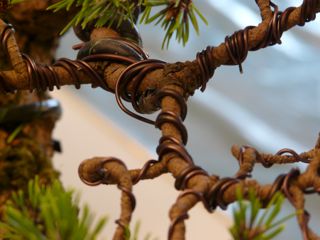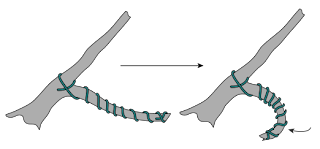 How To Begin:
How To Begin:If you study very carefully the way trees grow in nature, it is possible to design a realistic looking bonsai without knowing the names of styles, etc. The most important part is always remember that you are working with a living plant.
Look carefully at its natural characteristics and you may discern within them a suitable style, or styles.
Once a certain "shape" begins to reveal itself, you will find that gentle bending of a branch before wiring will increase its flexibility and give you an idea of the correct strength of wire. What you are looking for is a wire that will give you a tension slightly more than the tension of the branch.
Tender-barked trees, such as maples, should be trained with paper-wrapped wire to protect the bark.
When To Wire:
Deciduous trees should be wired after their leaves have matured, in early summer, and the wires removed in autumn to avoid wounding the bark.
Coniferous trees should be wired during the winter months, since they take considerably longer to become fixed in position. All trees should be protected from hot sun and heavy rain for a month after wiring.
 Wiring A Bonsai Tree:
Wiring A Bonsai Tree:Begin wiring from the base of the trunk, anchoring the wire in the soil. You may need two wires to hold the trunk in position. After securing the base of the trunk, proceed to the main, and then the smaller branches, ending with the highest twigs. Wires should be wound at about 45 degrees to the line of the branch.
Gauge the tension carefully, as tight wiring will cut into the bark, and loose wiring will slip.
Dealing With Breaks
 Even if you are very careful, you may bend a branch to its breaking point while wiring. If the break is simply a fracture with the broken part still partially attached, you have a chance of saving the branch.
Even if you are very careful, you may bend a branch to its breaking point while wiring. If the break is simply a fracture with the broken part still partially attached, you have a chance of saving the branch.Very gently ease the broken part into place, carefully fitting both ends of thebreak together. Wrap the break with garden tape or raffia and tie it securely, but not too tightly. Within several months, the fractured branch tissue may knit together.
If the break is complete or the ends fail to unite, you have several choices. You can cut the broken branch back to where side branches grow out from it, or you can cut it back to its point of origin.
Care After Wiring:
To help your bonsai recover from the trauma of wiring, keep it out of direct sunlight for several days. It's also a good idea to keep it sheltered from wind for several weeks. Water the plant routinely, giving the foliage a daily sprinkling.
Removing The Wire
To give wired branches a good chance to grow into their new positions, leave wires in place for a full growing season. Then, in early autumn, remove them to avoid any constriction during the next growth phase. If wires are left in plce too long, the bark will show unsightly spiral scars for years. With stiff copper wire, it is best to cut it carefully from branches to avoid inflicting damage by uncoiling.
Aluminum wire can be uncoiled, starting at the outmost end and carefully uncoiling toward the anchor end. If wired branches still need more coaxing to achieve the desired positions, they can be rewired at the appropriate time for another year of training. When you rewire a branch, vary the wire position from that of the previous year.







